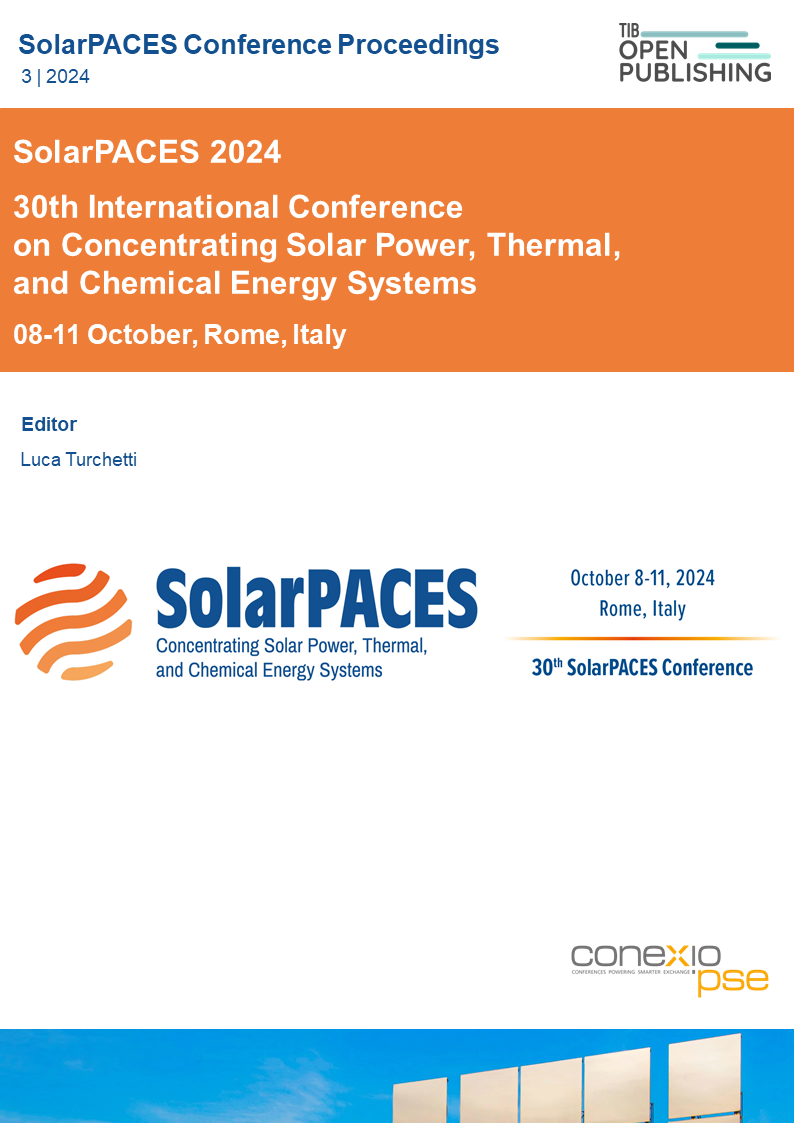Techno-Economic Analysis on Optimum Size of a Heliostat for High-Temperature Applications
DOI:
https://doi.org/10.52825/solarpaces.v3i.2423Keywords:
Concentrating Solar Thermal Power, Solar Tower Systems, Techno-Economic Analysis, Industrial Process HeatAbstract
This study investigates the impact of heliostat size on the levelized cost of heat (LCOH) and explores the trade-off between performance and cost for a baseline 160 MWth concentrating solar thermal (CST) tower system at high temperatures (565°C – 1550°C). The analysis assumes blackbody radiation for thermal losses at the receiver and employs ray tracing to assess optical losses in the heliostat field. A surrogate cost model is used to break down component costs for a specific commercial heliostat design (i.e., SunRing), considering volume production and operations and maintenance (O&M) costs to determine installation costs. The results indicate that heliostat size significantly affects the LCOH at different temperatures, with installation costs being a crucial factor in determining the optimal heliostat size. These installation costs vary by temperature and plant size due to power requirements and volume production considerations. The results motivate ongoing research to further refine the cost model and explore the projects of different sizes.
Downloads
References
IRENA, “Renewable Generation Costs in 2024,” Abu Dhabi, 2024. [Online]. Available: https://www.irena.org/-/media/Files/IRENA/Agency/Publication/2024/Sep/IRENA_Renewable_power_generation_costs_in_2023.pdf
A. Pfahl et al., “Progress in heliostat development,” Solar Energy, vol. 152, pp. 3–37, 2017, doi: 10.1016/j.solener.2017.03.029.
J. B. Blackmon, “Heliostat size optimization for central receiver solar power plants,” in Concentrating Solar Power Technology: Principles, Developments, and Applications, 2nd ed., Elsevier Ltd., 2020, pp. 585–631. doi: 10.1016/B978-0-12-819970-1.00016-5.
G. J. Kolb, C. K. Ho, T. R. Mancini, and J. A. Gary, “Power tower technology roadmap and cost reduction plan,” in Concentrating Solar Power: Data and Directions for an Emerging Solar Technology, 2012, pp. 223–250.
J. Coventry and J. Pye, “Heliostat cost reduction - Where to now?,” in Energy Procedia, Elsevier Ltd, 2014, pp. 60–70. doi: 10.1016/j.egypro.2014.03.007.
K. R. Bhargav, F. Gross, and P. Schramek, “Life cycle cost optimized heliostat size for power towers,” in Energy Procedia, Elsevier Ltd, 2014, pp. 40–49. doi: 10.1016/j.egypro.2014.03.005.
A. Pfahl, M. Randt, F. Meier, M. Zaschke, C. P. W. Geurts, and M. Buselmeier, “A Holis-tic Approach for Low Cost Heliostat Fields,” Energy Procedia, vol. 69, pp. 178–187, 2015, doi: 10.1016/j.egypro.2015.03.021.
A. Pidaparthi and J. Hoffmann, “Effect of heliostat size on the levelized cost of electricity for power towers,” in AIP Conference Proceedings, American Institute of Physics Inc., Jun. 2017. doi: 10.1063/1.4984381.
J. B. Blackmon, “Parametric determination of heliostat minimum cost per unit area,” So-lar Energy, vol. 97, pp. 342–349, Nov. 2013, doi: 10.1016/j.solener.2013.08.032.
F. Von Reeken, G. Weinrebe, T. Keck, and M. Balz, “Heliostat cost optimization study,” in AIP Conference Proceedings, 2016. doi: 10.1063/1.4949259.
A. Zolan, C. Augustine, K. Armijo, Y. Wang, and J. Pye, “Impact of Temperature and Optical Error on the Combined Optical and Thermal Efficiency of Solar Tower Systems for Industrial Process Heat,” SolarPACES 2023 abstracts, no. 2, pp. 4–5, 2023.
G. Zhu et al., “HelioCon: A roadmap for advanced heliostat technologies for concentrat-ing solar power,” Sol. Energy, vol. 264, p. 111917, Nov. 2023. doi: 10.1016/j.solener.2023.111917.
W. T. Hamilton, M. J. Wagner, and A. J. Zolan, “Demonstrating SolarPILOT’s python API through heliostat optimal aimpoint strategy use case,” Proceedings of the ASME 2021 15th International Conference on Energy Sustainability, ES 2021, no. April, 2021, doi: 10.1115/ES2021-60502.
M. J. Wagner and T. Wendelin, “SolarPILOT: A power tower solar field layout and char-acterization tool,” Solar Energy, vol. 171, pp. 185–196, 2018, doi: 10.1016/j.solener.2018.06.063.
K. Kattke, “Drop C: The Drop-In, Ring-of-Power Heliostat (Final Report),” pp. 1–101, 2023, [Online]. Available: https://www.osti.gov/servlets/purl/1973845/
P. Kurup et al., “Cost Update : Commercial and Advanced Heliostat Collectors Cost Up-date : Commercial and Advanced Heliostat Collectors,” no. February, 2022.
L. Li, B. Wang, J. Pye, and W. Lipiński, “Temperature-based optical design, optimization and economics of solar polar-field central receiver systems with an optional compound parabolic concentrator,” Solar Energy, vol. 206, no. May, pp. 1018–1032, 2020, doi: 10.1016/j.solener.2020.05.088.
A. Steinfeld and M. Schubnell, “Optimum aperture size and operating temperature of a solar cavity-receiver,” Sol. Energy, vol. 50, no. 1, pp. 19–25, 1993, doi: 10.1016/0038-092X(93)90004-8.
A. Zolan, E. Westphal, C. Augustine, K. Armijo, Y. Wang, and J. Pye, “Impact of process temperature on the cost of concentrating solar thermal industrial process heat,” Solar En-ergy, vol. 293, p. 113427, Jun. 2025, doi: 10.1016/j.solener.2025.113427.
D. Tilley, “Baseload Nitrate Salt Central Receiver Power Plant Design Abengoa Solar LLC,” no. 5, 2014.
W. G. J. H. M. van Sark, “Introducing errors in progress ratios determined from experi-ence curves,” Technol Forecast Soc Change, vol. 75, no. 3, pp. 405–415, 2008, doi: 10.1016/j.techfore.2007.03.006.
W. Y. Park and M. A. Mcneil, “Using learning curves on energy- efficient technologies to estimate future energy savings and emission reduction potentials in the U.S. iron and steel industry,” Lbnl, no. June, 2015.
Published
How to Cite
Conference Proceedings Volume
Section
License
Copyright (c) 2025 Ahmed Gamil, Alexander Zolan, Chad Augustine, Guangdong Zhu, Kenneth Armijo

This work is licensed under a Creative Commons Attribution 4.0 International License.
Accepted 2025-04-22
Published 2025-10-09
Funding data
-
Solar Energy Technologies Office
Grant numbers 38488
